情态动词的用法要点
一. can和could
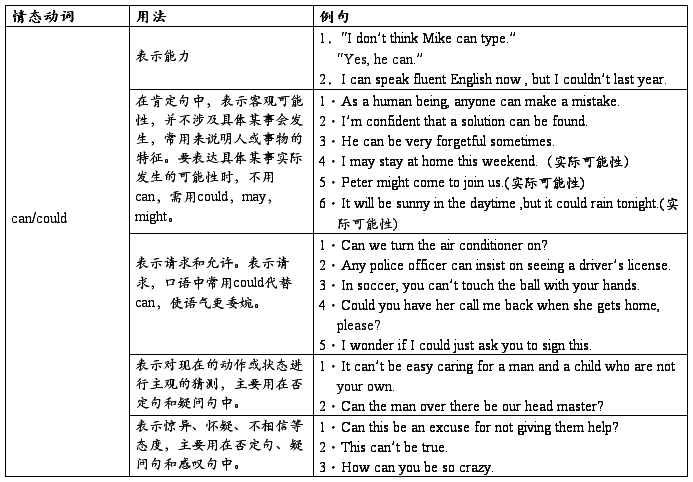
特别说明:
(1) could用来表示请求时,语气委婉,主要用于疑问句,不能用于肯定句,答语应用can(即:could不能用于现在时态的简略答语中)。如:
——Could I use your dictionary?
——Yes, you can.(否定回答可用:No, I’m afraid not.)
(2) can和be able to辨析
can(could)和be able to都可以表示能力,意思上没有区别。但can只有现在式和过去式,而be able to则有更多的形式。如:
I’ve always wanted to able to speak fluent English.
Those bags look really heavy, are you sure you’ll be able to carry them on your own?
但是,表示在过去某时的某一场合经过一番努力,终于做成了某事,通常不用could,而用was/were able to来表示。这时,was/were able to相当于managed to do或succeed in doing。如:
After the accident it was a long time before she was able to walk again.
The fire was very big, but most people were able to escape from the building.
(3) 惯用形式“cannot …too…”表示“无论怎么……也不(过分)”。如:
You cannot be too careful.你越小心越好。
惯用形式“cannot but+ 不定式(不带to)”表示“不得不,只好”。如:
I cannot but admire her determination.我不得不钦佩你的决心。
二.may和 might
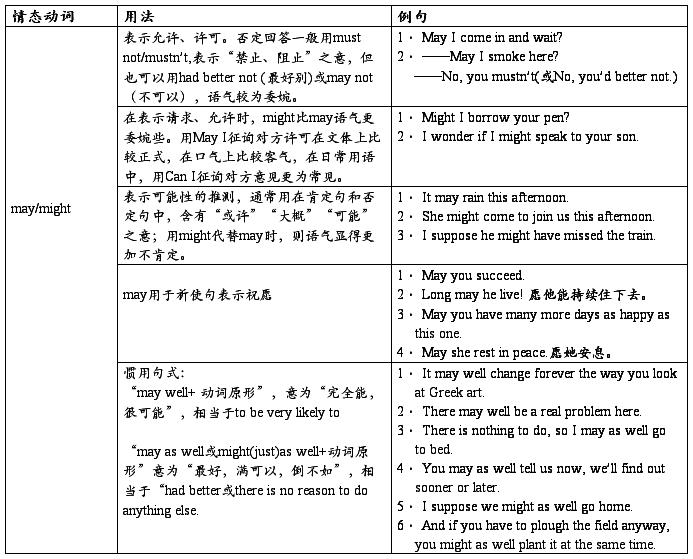
二.must和have to
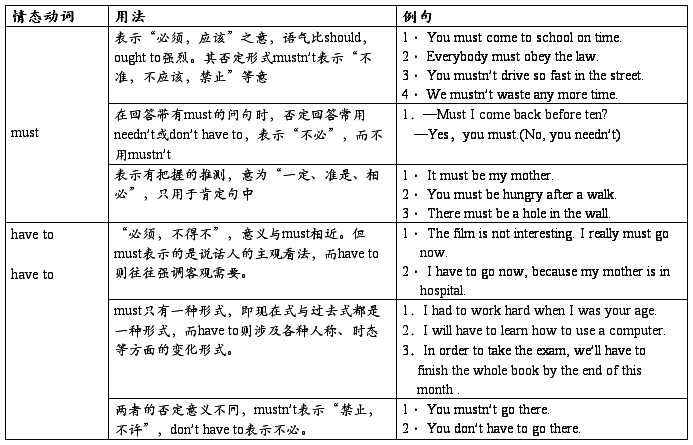
四.shall和should
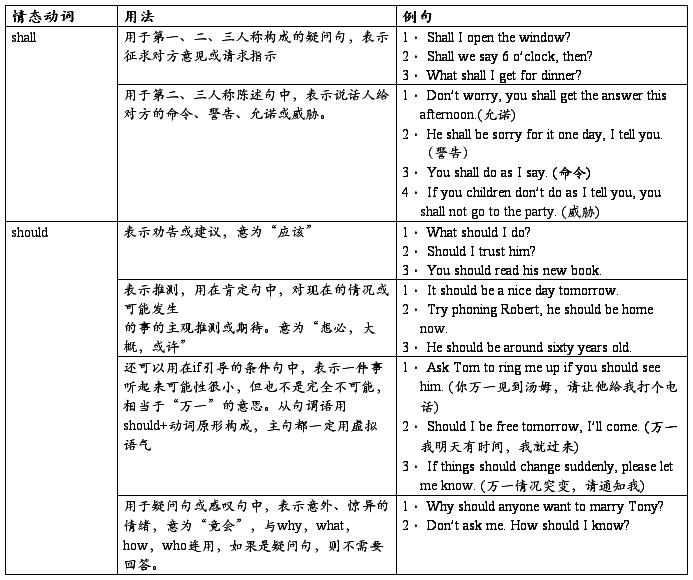
五.will和would
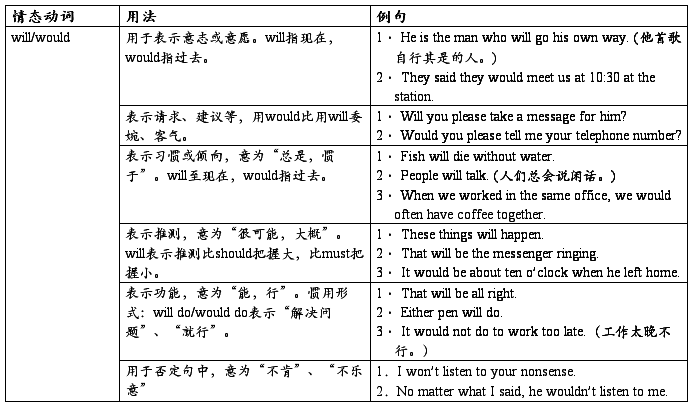
特别说明:would与used to辨析
would可用来表示过去反复出现的动作,但不能表示过去存在的状态,所以我们不能说:“she would be a quiet girl.”
另外,would强调过去某种特定情况下的活动,是完全过去的事情,同现在没有联系。而used to则着眼于过去和现在的对比,隐含现在已不存在,动作或状态都可表示。Would可以表示不规则的习惯,used to则不可。如:
He used to be a naughty boy and cause trouble.
I used to get up at six in the morning.
Sometimes she would take a walk in the neighboring woods.
In those days, whenever I had difficulties, I would go to Mr. Chen for help.
六.need和dare
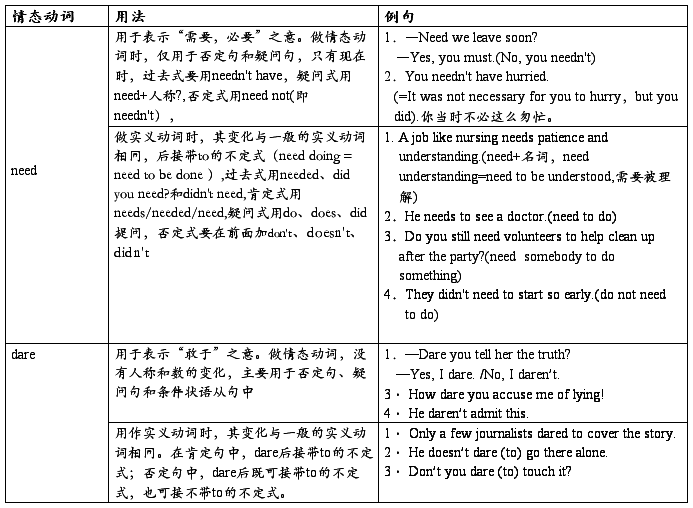
七.ought的用法:

说明:should与ought to 表示“应该”时的区别
should 表示自己的主观看法,而ought to的语气中,含有“按道理应该……”之意。若要反映客观情况或涉及法律义务和规定,一般用ought to。如:
You should help them with their work.
You are his father. You ought to get him to receive good education.
八.“情态动词+have done”用法
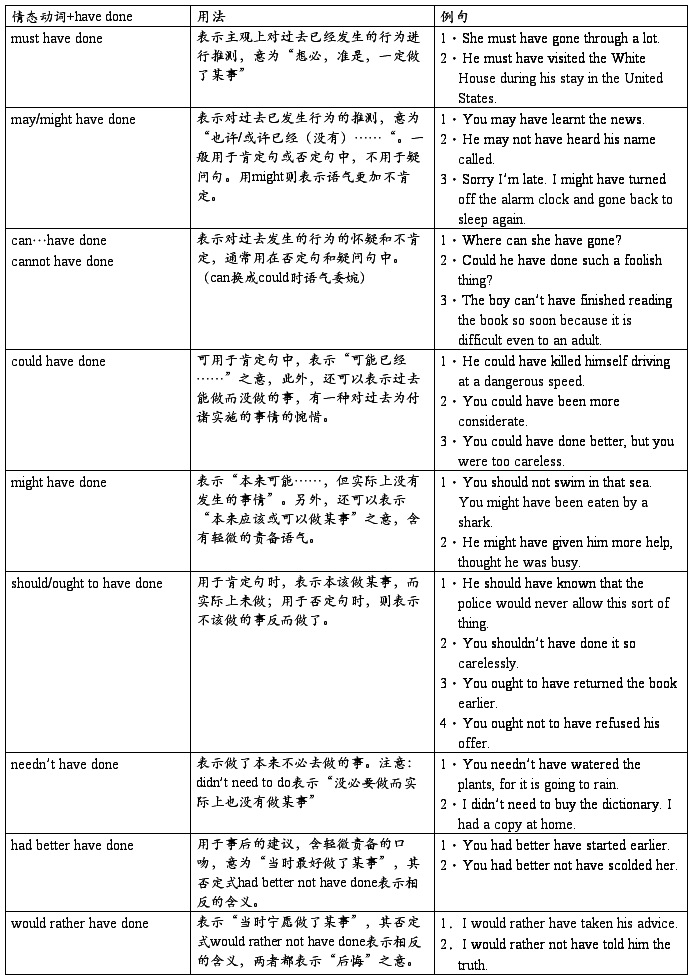
第二篇:情态动词用法归纳
情态动词有can (could), may (might), must, have to, shall (should, will (would), dare (dared), need (needed), ought to等。 情态动词无人称和数的变化;不能单独使用,必须与其后的动词原形构成谓语
一、 can, could
1) 表示能力(体力、知识、技能)。
Can you lift this heavy box?(体力)
Mary can speak three languages.(知识)
Can you skate?(技能)
此时可用be able to代替。Can只有一般现在时和一般过去式;而be able to则有更多的时态。
I’ll not be able to come this afternoon.
当表示“经过努力才得以做成功某事”时应用be able to,不能用Can。如:
He was able to go to the party yesterday evening in spite of the heavy rain.
2) 表示请求和允许。
-----Can I go now?
----- Yes, you can. / No, you can’t.
此时可与may互换。在疑问句中还可用could,
might代替,不是过去式,只是语气更委婉,不能用于肯定句和答语中。
---- Could I come to see you tomorrow?
---- Yes, you can. ( No, I’m afraid not. )
3) 表示客观可能性(客观原因形成的能力)。
They’ve changed the timetable, so we can go by bus instead.
This hall can hold 500 people at least.
4) 表示推测(惊讶、怀疑、不相信的态度),用于疑问句、否定句和感叹句中。 Can this be true?
This can’t be done by him.
How can this be true?
二、 may, might
1) 表示请求和允许。might比 may语气更委婉,而不是过去式。否定回答时可用can’t 或mustn’t,表示“不可以,禁止”。
----Might/ May I smoke in this room?
---- No, you mustn’t.
---- May/Might I take this book out of the room?
---- Yes, you can. (No, you can’t / mustn’t. )
用May I...?征徇对方许可时比较正式和客气,而用Can I...?在口语中更常见。
2)用于祈使句,表示祝愿。
May you succeed!
3) 表示推测、可能性(不用于疑问句)。
might不是过去式,它所表示的可能性比may小。
1.He may /might be very busy now.
2.Your mother may /might not know the truth.
三、 must, have to
1) 表示必须、必要。
You must come in time.
在回答引出的问句时,如果是否定的,不能用mustn’t(禁止,不准),而用needn’t, don’t have to(不必).
---- Must we hand in our exercise books today?
---- Yes, you must.
---- No, you don’t have to / you needn’t.
2) must是说话人的主观看法, 而have to则强调客观需要。Must只有一般现在时, have to 有更多的时态形式。
1. he play isn’t interesting, I really must go now.
2. I had to work when I was your age.
3) 表示推测、可能性(只用于肯定的陈述句)
1. You’re Tom’s good friend, so you must know what he likes best.
2. Your mother must be waiting for you now.
四、 dare, need
1) dare作情态动词用时, 常用于疑问句、否定句和条件从句中, 过去式形式为dared。
1. How dare you say I’m unfair?
2. He daren’t speak English before such a crowd, dare he?
3. If we dared not go there that day, we couldn’t get the beautiful flowers.
2) need 作情态动词用时, 常用于疑问句、否定句。在肯定句中一般用must, have to, ought to, should代替。
1.You needn’t come so early.
2. ---- Need I finish the work today?
---- Yes, you must. / No, you needn’t.
3) dare和 need作实义动词用时, 有人称、时态和数的变化。在肯定句中,dare后面常接带to的不定式。在疑问句和否定句中,dare后面可接带to或不带to的不定式。而need后面只能接带to的不定式。
1. I dare to swim across this river.
2. He doesn’t dare (to) answer.
3. He needs to finish his homework today.
五、 shall, should
1) shall 用于第一人称,征求对方的意见。
What shall we do this evening?
2) shall 用于第二、三人称,表示说话人给对方的命令、警告、允诺或威胁。
1. You shall fail if you don’t work hard.(警告)
2. He shall have the book when I finish it.(允诺)
3. He shall be punished.(威胁)
六、 will, would
1) 表示请求、建议等,would更委婉。
Will / Would you pass me the ball, please?
2) 表示意志、愿望和决心。
1. I will never do that again.
2. They asked him if he would go abroad.
3) would表示过去反复发生的动作或某种倾向。would表示过去习惯时比used to正式,且没有“现已无此习惯”的含义。
1. During the vacation, he would visit me every other day.
2. The wound would not heal.
4) 表示估计和猜想。
It would be about ten o’clock when she left home.
七、 should, ought to
1) should, ought to表示“应该”,ought to表示义务或责任,比should语气重。
1. I should help her because she is in trouble.
2. You ought to take care of the baby.
2) 表示劝告、建议和命令。should, ought to可通用,但在疑问句中常用should。
1. You should / ought to go to class right away.
2. Should I open the window?
3) 表示推测
should , ought to (客观推测), must(主观推测)。
1.He must be home by now. (断定他已到家)
2.He ought to/should be home by now.(不太肯定)
3. This is where the oil must be.(直爽)
4. This is where the oil ought to/should be.(含蓄)
从高考题看情态动词的用法
最近几年高考试题中常常借助语境来考查情态动词的基本用法及其区别,因此在平时学习时准确理解和掌握情态动词的基本用法十分重要。情态动词的用法复杂多变,在高考试题中,命题者常常利用语境和句子之间意义上的细微差别来考查学生对情态动词的理解和掌握。对于情态动词,除了要求考生能够准确掌握它们的基本用法外,还要充分利用高考试题所设置的语境来分析句子之间所体现的特殊关系。下面就近几年来高考试题中出现的情态动词的考点进行归纳分析,以便同学们复习掌握。
一、用“情态动词+have +done”结构表示对过去动作的推测,高考试题中常用过去时态或过去的时间状语给以暗示。情态动词的这一用法可以用 “对立统一”来概括。
1.当试题的前句和后句在动作和意义上相互补充说明,且整个句意在动作和时间上是一个整体时,我们可用“统一”关系来解决这样的试题。常见的结构有:
must have done: 表示对过去动作的肯定推测,常译作“一定做了……”,只能用于肯定句中。其否定形式为can’t/couldn’t have done 疑问式为Can/Could...have done?。 could /might have done:表示对过去发生的动作的可能性推测,常译作“可能做了……”。如:
1) Sorry I’m late. I _____ have turned off the alarm clock and gone back to sleep again. (北京 20xx春)
A. might B. should C. can D. will
该题前句说明了结果,后句接着说出了产生这种结果的可能性,对前句进行补充说明。分析选项可知本题应选A。
2) My sister met him at the Grand Theater yesterday afternoon, so he _____ your lecture. (上海 20xx)
A. couldn’t have attended
B. needn’t have attended
C. mustn’t have attended
D. shouldn’t have attended
该题前句叙说一个客观事实,后句对前句进行补充说明,分析选项可知C是错误的 而B、
D两项不符合题意。故本题选A。又如:
Jack ____ yet, otherwise he would have telephoned me. (上海’97)
A. mustn’t have arrived
B. shouldn’t have arrived
C. can’t have arrived
D. need not have arrived (C)
2.当试题的前后句在动作和意义上构成转折关系时,常借助“but, however, instead”等词来表示过去的动作与客观事实不符,这时我们就可以用“对立”关系来解决这样的试题。这种结构常见的有:
should have done / ought to have done:表示过去本应该做某事而实际上没有做。 should not have done / ought not to have done:表示过去本不应该做某事但事实上却做了。
need have done:表示过去本来有必要去做某事,但事实上没有做。
need not have done:表示过去本来没有必要做某事,但事实上却做了。如:
3) I was really anxious about you. You _____ home without a word. (NMET20xx)
A. mustn’t leave B. shouldn’t have left
C. couldn’t have left D. needn’t leave
分析该题前后句之间的关系和语气可知,事实上是 “本不应该离家出走却走了”,故本题选B。
4) I told Sally how to get here, but perhaps I _____ for her. (NMET’94)
A. had to write it out
B. must have written it out
C. should have written it out
D. ought to write it out
由句中的连词but可知前后句之间是对立关系,分析题意可知本题应选C。
二、考查情态动词基本用法之间的比较和辨析。最近几年高考试题中常借助具体的语境来考查考生对那些最常见的情态动词的基本用法的理解和掌握,因此在做这样的试题时应认真分析语境中所含的实际意义,并结合情态动词的基本含义和用法做出正确的选择。
6) —I hear you’ve got a set of valuable Australian coins. _________ I have look? —Yes, certainly. (北京20xx春)
A. Do B. May C. Shall D. Should
分析语境可知这是在征求对方的许可,may表示“允许、可以”,语气比较委婉 shall常用于第一、三人称作主语的疑问句中,表示征求对方意见和指示,如果此空用shall,则意为“要(我)看一下吗?”,不符合上下文意思。故本题选B。
7) Mr Bush is on time for everything. How ____ it be that he was late for the opening ceremony? (上海20xx春)
A. can B. should C. may D. must
must be 表示肯定的猜测,只能用于肯定句中,由题意可知本题应选A。
8) Are you coming to Jeff’s party?
I’m not sure. I ____ go to the concert instead. (NMET20xx)
A. must B. would C. should D. might
由题意和下句中的 “I’m not sure” 可知这段对话中存在一种可能性推测,might可以用来表示一种比较委婉的可能性判断,故本题选D。
9) Johnny, you ____ play with the knife, you ____ hurt yourself. (NMET’96)
A. won’t; can’t B. mustn’t; may
C. shouldn’t; must D. can’t; shouldn’t
mustn’t 表示“不可以;禁止”,分析题意可知第二个空表示某种可能性,故本题选B。
10) —Will you stay for lunch?
—Sorry, ______. My brother is coming to see me. (NMET’99)
A. I mustn’t B. I can’t
C. I needn’t D. I won’t
分析题意可知因为“我弟弟要来看我”,所以“不能留下”,因此对别人的邀请或要求应给予礼貌的拒绝。A 项表示“禁止”;C项表示“不必要”;而D项表示“不会”,均不符合题意。故本题选B。)
11)—When can I come for the photos? I need them tomorrow afternoon.
—They _____ be ready by 1200. (NMET’98)
A. can B. should C. might D. need
该题考查情态动词should的基本含义,分析句意可知本题应选B。
The fire spread through the hotel very quickly but everyone ____ get out.(NMET’97)
A. had to B. would C. could D. was able to
该题考查了could和be able to的区别,二者都可表示过去时间的能力,但如果表示过去成功地做了某事只能使用was / were able to do,故本题选D。
13) —Shall I tell John about it ?
—No, you _____. I’ve told him already. (NMET’94)
A. needn’t B. wouldn’t C. mustn’t D. shouldn’t
情态动词shall在试题中表示征询对方意见或请求指示。答句暗示 “没有必要了”,故本题选A。
